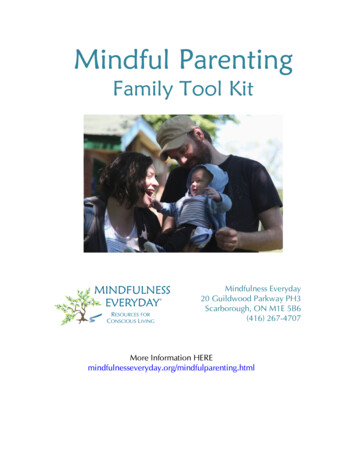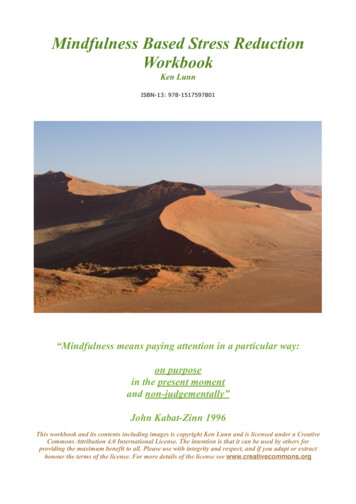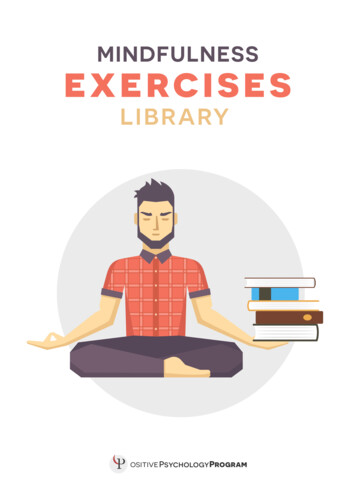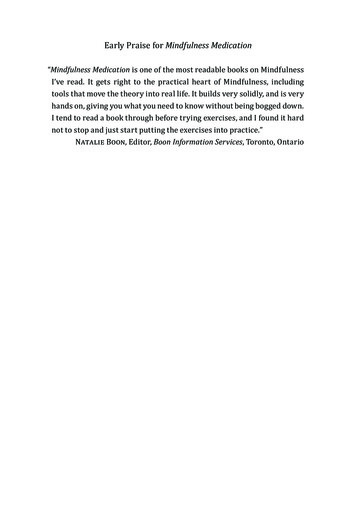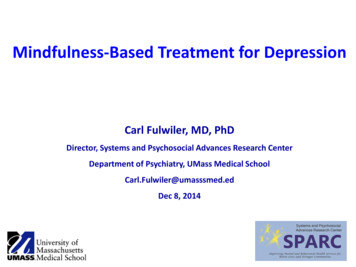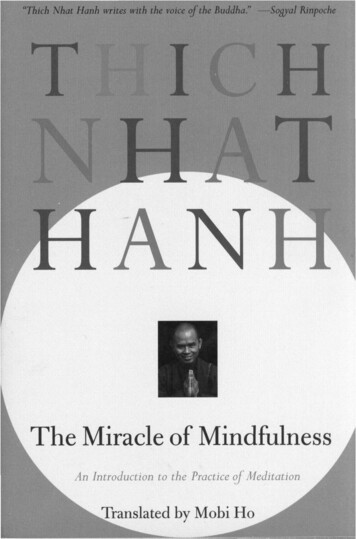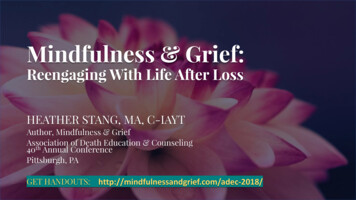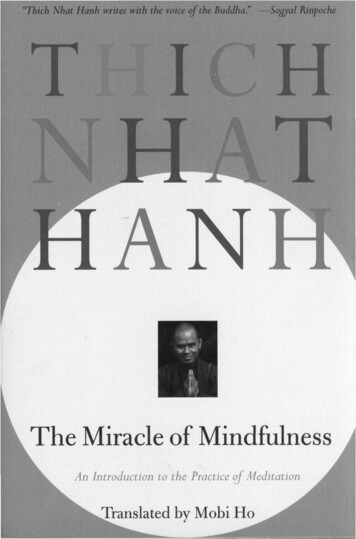
Transcription
The Miracle of MindfulnessAn Introduction to the Practiceif MeditationTranslated by Mobi Ho
Thich Nhat Hanh Translated by Mobi Ho With Eleven Drawings by Vo-Dinh Mai
The Miracleof MindfulnessAn Introduction to the Practiceof Meditation Beacon PressBoston
Beacon Press25 Beacon StreetBoston, Massachusetts 02108-2892www.beacon.orgBeacon Press booksare published under the auspices ofthe Unitarian Universalist Association of Congregations. 1975, 1976 by Thich Nhat HanhPreface and English translation 1975, 1976, 1987byMobiHoAfterword 1976 by James ForestArtwork 1987 by Vo-Dinh MaiAll rights reservedPrinted in the United States of America09 08 07 06 05 11 10 9 8 7The Library of Congress catalogued the previouspaperback edition as follows:Nhiit Hanh, Thich.The miracle of mindfulness.Translation of Phep la cua su tinh thuc.ISBN 0-8070-1232-7 (cloth)ISBN 0-8070-1239-4 (paper)1. Meditation (Buddhism) 2. Buddhist meditations.I. Title.BQ5618.V5N4813 1987294.3'433 87-42582
ContentsTranslator's Preface by Mobi HoOneThe Essential Disciplinevii1TwoThe Miracle Is to Walk on EarthThreeA Day of Mindfulness1127FourThe Pebble33FiveOne Is All, All Is One: The Five AggregatesSixThe Almond Tree in Your Front YardSevenThree Wondrous Answersv695545
Exercises in Mindfulness79Nhat Hanh: Seeing with the Eyes of Compassionby James Forest101Selection of Buddhist Sutrasvi109
Translator's PrefaceThe Miracle of Mindfulness was originally written inVietnamese as a long letter to Brother Quang, amain staff member of the School of Youth for Social Service in South Vietnam in 1974. Its author,the Buddhist monk Thich Nhat Hanh, hadfounded the School in the 1960s as an outgrowthof "engaged Buddhism." It drew young peopledeeply committed to acting in a spirit of compassion. Upon graduation, the students used thetraining they received to respond to the needs ofpeasants caught in the turmoil of the war. Theyhelped rebuild bombed villages, teach children,set up medical stations, and organize agriculturalcoopera tives.The workers' methods of reconciliation wereoften misunderstood in the atmosphere of fearand mistrust engendered by the war. They persistently refused to support either armed partyvii
and believed that both sides were but the reflection of one reality, and the true enemies were notpeople, but ideology, hatred, and ignorance.Their stance threatened those engaged in the conflict, and in the first years of the School, a seriesof attacks were carried out against the students.Several were kidnapped and murdered. As thewar dragged on, even after the Paris Peace Accords were signed in 1973, it seemed at times impossible not to succumb to exhaustion andbitterness. Continuing to work in a spirit of loveand understanding required great courage.From exile in France, Thich Nhat Hanh wroteto Brother Quang to encourage the workers during this dark time. Thay Nhat Hanh ("Thay," theform of address for Vietnamese monks, means"teacher") wished to remind them of the essentialdiscipline of following one's breath to nourish andmaintain calm mindfulness, even in the midst ofthe most difficult circumstances. Because BrotherQuang and the students were his colleagues andfriends, the spirit of this long letter that becameThe Miracle of Mindfulness is personal and direct.When Thay speaks here of village paths, hespeaks of paths he had actually walked withBrother Quang. When he mentions the bright eyesof a young child, he mentions the name of BrotherQuang's own son.I was living as an American volunteer withthe Vietnamese Buddhist Peace Delegation inParis when Thay was writing the letter. Thayheaded the delegation, which served as an overviii
seas liaison office for the peace and reconstructionefforts of the Vietnamese Buddhists, including theSchool of Youth for Social Service. I remember lateevenings over tea, when Thay explained sectionsof the letter to delegation members and a few closefriends. Quite naturally, we began to think ofother people in other countries who might alsobenefit from the practices described in the book.Thay had recently become acquainted withyoung Buddhists in Thailand who had been inspired by the witness of engaged Buddhism inVietnam. They too wished to act in a spirit ofawareness and reconciliation to help avert thearmed conflict erupting in Thailand, and theywanted to know how to work without being overcome by anger and discouragement. Several ofthem spoke English, and we discussed translatingBrother Quang's letter. The idea of a translationtook on a special poignancy when the confiscationof Buddhist publishing houses in Vietnam madethe project of printing the letter as a small bookin Vietnam impossible.I happily accepted the task of translating thebook into English. For nearly three years, I hadbeen living with the Vietnamese Buddhist PeaceDelegation, where day and night I was immersedin the lyrical sound of the Vietnamese language.ThaY'had been my "formal" Vietnamese teacher;we had slowly read through some of his earlierbooks, sentence by sentence. I had thus acquireda rather unusual vocabulary of VietnameseBuddhist terms. Thay, of course, had been teachix
ing me far more than language during those threeyears. His presence was a constant gentle reminder to return to one's true self, to be awakeby being mindful.As I sat down to translate The Miracle of Mindfulness, I remembered the episodes during the pastyears that had nurtured my own practice of mindfulness. There was the time I was cooking furiously and could not find a spoon I'd set downamid a scattered pile of pans and ingredients. AsI searched here and there, Thay entered thekitchen and smiled. He asked, "What is Mobilooking for?" Of course, I answered, "The spoon!I'm looking for a spoon!" Thay answered, againwith a smile, "No, Mobiis looking for Mobi."Thay suggested I do the translation slowlyand steadily, in order to maintain mindfulness. Itranslated only two pages a day. In the evenings,Thay and I went over those pages, changing andcorrecting words and sentences. Other friendsprovided editorial assistance. It is difficult to describe the actual experience of translating hiswords, but my awareness of the feel of pen andpaper, awareness of the position of my body andof my breath enabled me to see most clearly themindfulness with which Thay had written eachword. As I watched my breath, I could see BrotherQuang and the workers of the School of Youthfor Social Service. More than that, I began to seethat the words held the same personal and livelydirectness for any reader because they had beenx
written in mindfulness and lovingly directed toreal people. As I continued to translate, I couldsee an expanding community-the School's workers, the young Thai Buddhists, and many otherfriends throughout the world.When the translation was completed wetyped it, and Thay printed a hundred copies onthe tiny offset machine squeezed into the delegation's bathroom. Mindfully addressing eachcopy to friends in many countries was a happytask for delegation members.Since then, like ripples in a pond, The Miracleof Mindfulness has traveled far. It has been translated into several other languages and has beenprinted or distributed on every continent in theworld. One of the joys of being the translator hasbeen to hear from many people who have discovered the book. I once met someone in a bookstorewho knew a student who had taken a copy tofriends in the Soviet Union. And recently, I meta young Iraqi student in danger of being deportedto his homeland, where he faces death for hisrefusal to fight in a war he believes cruel andsenseless; he and his mother have both read TheMiracle of Mindfulness and are practicing awarenessof the breath. I have learned, too, that proceedsfrom the Portuguese edition are being used to assist poor children in Brazil. Prisoners, refugees,health-care workers, educators, and artists areamong those whose lives have been touched bythis little book. I often think of The Miracle of Mind-xi
fulness as something of a miracle itself, a vehiclethat continues to connect lives throughout theworld.American Buddhists have been impressed bythe natural and unique blending of Theravada andMahayana traditions, characteristic of VietnameseBuddhism, which the book expresses. As a bookon the Buddhist path, The Miracle of Mindfulnessis special because its clear and simple emphasison basic practice enables any reader to begin apractice of his or her own immediately. Interestin the book, however, is not limited to Buddhists.It has found a home with people of many differentreligious traditions. One's breath, after all, ishardly attached to any particular creed.Those who enjoy this book will likely be interested in other books by Thich Nhat Hanh whichhave been translated into English. His books inVietnamese, including short stories, novels, essays, historical treatises on Buddhism and poetry,number in the dozens. While several of his earlierbooks in English are no longer in print, more recent works available in translation include A Guideto Walking Meditation, Being Peace, and The Sun MyHeart.Denied permission to return to Vietnam,Thich Nhat Hanh spends most of the year livingin Plum Village, a community he helped found inFrance. There, under the guidance of the sameBrother Quang to whom The Miracle of Mindfulnesswas originally addressed years ago, communitymembers tend hundreds of plum trees. Profitsxii
from the sales of their fruit are used to assist hungry children in Vietnam. In addition, Plum Villageis open every summer to visitors from around theworld who wish to spend a month of mindfulnessand meditation. In recent years, Thich Nhat Hanhhas also made annual visits to the United Statesand Canada to conduct week-long retreats organized by the Buddhist Peace Fellowship.I would like to express special gratitude toBeacon Press for having the vision to print thisnew edition of The Miracle of Mindfulness. I hopethat each new person whom it reaches will sensethat the book is addressed as personally to himor her as it was to Brother Quang and the workersof the School of Youth for Social Service.Mobi HoAugust 1987xiii
The Miracle ofMindfulness
One The Essential Discipline,Yesterday Allen came over to visitwith his son Joey. Joey has grown soquickly! He's already seven years oldand is fluent in French and English. He even usesa bit of slang he's picked up on the street. Raisingchildren here is very different from the way weraise children at home. Here parents believe that"freedom is necessary for a child's development."During the two hours that Allen and I weretalking, Allen had to keep a constant eye on Joey.Joey played, chattered away, and interruptedus, making it impossible to carryon a real conversation. I gave him several picture books forchildren but he barely glanced at them beforetossing them aside and interrupting our conversation again. He demands the constant attention of grown-ups.Later, Joey put on his jacket and went outside to play with a neighbor's child. I askedAllen, "Do you find family life easy?" Allen1
didn't answer directly. He said that during thepast few weeks, since the birth of Ana, he hadbeen unable to sleep any length of time. Duringthe night, Sue wakes him up and-because sheis too tired herself-asks him to check to makesure Ana is still breathing. "I get up and lookat the baby and then come back and fall asleepagain. Sometimes the ritual happens two orthree times a night.""ls family life easier than being a bachelor?" I asked. Allen didn't answer directly. ButI understood. I asked another question: "A lotof people say that if you have a family you'reless lonely and have more security. Is thattrue?" Allen nodded his head and mumbledsomething softly. But I understood.Then Allen said, "l've discovered a way tohave a lot more time. In the past, I used to lookat my time as if it were divided into severalparts. One part I reserved for Joey, another partwas for Sue, another part to help with Ana, another part for household work. The time leftover I considered my own. I could read, write,do research, go for walks."But now I try not to divide time into partsanymore. I consider my time with Joey and Sueas my own time. When I help Joey with his homework, I try to find ways of seeing his time as myown time. I go through his lesson with him,sharing his presence and finding ways to beinterested in what we do during that time. Thetime for him becomes my own time. The samewith Sue. The remarkable thing is that now Ihave unlimited time for myself!"2
Allen smiled as he spoke. I was surprised.I knew that Allen hadn't learned this from reading any books. This was something he haddiscovered for himself in his own daily life.Washing the dishes to wash the dishesThirty years ago, when I was still a noviceat Tu Hieu Pagoda, washing the dishes washardly a pleasant task. During the Season ofRetreat when all the monks returned to themonastery, two novices had to do all the cookingand wash the dishes for sometimes well overone hundred monks. There was no soap. We hadonly ashes, rice husks, and coconut husks, andthat was all. Cleaning such a high stack of bowlswas a chore, especially during the winter whenthe water was freezing cold. Then you had toheat up a big pot of water before you could doany scrubbing. Nowadays one stands in a kitchenequipped with liquid soap, special scrubpads,and even running hot water which makes it allthe more agreeable. It is easier to enjoy washingthe dishes now. Anyone can wash them in ahurry, then sit down and enjoy a cup of teaafterwards. I can see a machine for washingclothes, although I wash my own things out byhand, but a dishwashing machine is going justa little too far!While washing the dishes one should onlybe washing the dishes, which means that whilewashing the dishes one should be completelyaware of the fact that one is washing the dishes.At first glance, that might seem a little silly:3
why put so much stress on a simple thing? Butthat's precisely the point. The fact that I amstanding there and washing these bowls is awondrous reality. I'm being completely myself,following my breath, conscious of my presence,and conscious of my thoughts and actions.There's no way I can be tossed around mindlessly like a bottle slapped here and there onthe waves.The cup in your handsIn the United States, I have a close friendnamed Jim Forest. When I first met him eightyears ago, he was working with the CatholicPeace Fellowship. Last winter, Jim came to visit.I usually wash the dishes after we've finishedthe evening meal, before sitting down and drinking tea with everyone else. One night, Jim askedif he might do the dishes. I said, "Go ahead, butif you wash the dishes you must know the wayto wash them." Jim replied, "Come on, you thinkI don't know how to wash the dishes?" I answered, "There are two ways to wash the dishes.The first is to wash the dishes in order to haveclean dishes and the second is to wash the dishesin order to wash the dishes." Jim was delightedand said, "I choose the second way-to wash thedishes to wash the dishes." From then on, Jimknew how to wash the dishes. I transferred the"responsibility" to him for an entire week.If while washing dishes, we think onlyof the cup of tea that awaits us, thus hurryingto get the dishes out of the way as if they were4
a nuisance, then we are not "washing the dishesto wash the dishes." What's more, we are notalive during the time we are washing the dishes.In fact we are completely incapable of realizingthe miracle of life while standing at the sink. Ifwe can't wash the dishes, the chances are wewon't be able to drink our tea either. Whiledrinking the cup of tea, we will only be thinkingof other things, barely aware of the cup in ourhands. Thus we are sucked away into the future-and we are incapable of actually living oneminute of life.Eating a tangerineI remember a number of years ago, whenJim and I were first traveling together in theUnited States, we sat under a tree and shared atangerine. He began to talk about what wewould be doing in the future. Whenever wethought about a project that seemed attractiveor inspiring, Jim became so immersed in it thathe literally forgot about what he was doing inthe present. He popped a section of tangerinein his mouth and, before he had begun chewingit, had another slice ready to pop into his mouthagain. He was hardly aware he was eating atangerine. All I had to say was, "You ought toeat the tangerine section you've already taken."Jim was startled into realizing what he wasdoing.It was as if he hadn't been eating the tangerine at all. If he had been eating anything, hewas "eating" his future plans.5
A tangerine has sections. If you can eat justone section, you can probably eat the entiretangerine. But if you can't eat a single section,you cannot eat the tangerine. Jim understood. Heslowly put his hand down and focused on thepresence of the slice already in his mouth. Hechewed it thoughtfully before reaching downand taking another section.Later, when Jim went to prison for activitiesagainst the war, I was worried about whetherhe could endure the four walls of prison and senthim a very short letter: "00 you remember thetangerine we shared when we were together?Your being there is like the tangerine. Eat it andbe one with it. Tomorrow it will be no more."The Essential DisciplineMore than thirty years ago, when I firstentered the monastery, the monks gave me asmall book called "The Essential Discipline forDaily Use," written by the Buddhist monk DocThe from Bao Son pagoda, and they told me tomemorize it. It was a thin book. It couldn't havebeen more than 40 pages, but it contained allthe thoughts Doc The used to awaken his mindwhile doing any task. When he woke up in themorning, his first thought was, "Just awakened,I hope that every person will attain great awareness and see in complete clarity." When hewashed his hands, he used this thought to placehimself in mindfulness: "Washing my hands, Ihope that every person will have pure hands toreceive reality." The book is comprised entirely6
of such sentences. Their goal was to help thebeginning practitioner take hold of his ownconsciousness. The Zen Master Doc The helpedall of us young novices to practice, in a relativelyeasy way, those things which are taught in theSutra of Mindfulness. Each time you put onyour robe, washed the dishes, went to the bathroom, folded your mat, carried buckets of water,or brushed your teeth, you could use one of thethoughts from the book in order to take holdof your own consciousness.The Sutra of Mindfulness· says, "Whenwalking, the practitioner must be conscious thathe is walking. When sitting, the practitionermust be conscious that he is sitting. When lyingdown, the practitioner must be conscious thathe is lying down . . . . No matter what positionone's body is in, the practitioner must be conscious of that position. Practicing thus, thepractitioner lives in direct and constant mindfulness of the body . . ." The mindfulness of* In the Sutras, Buddha usually teaches that one shoulduse one's breath in order to achieve Concentration. The Sutrawhich speaks about the use of your breath to maintain mindfulness is the Anapanasati Sutra. This Sutra was translatedand commentated on by a Vietnamese Zen Master of CentralAsian origin named Khuong Tang Hoi, around the beginningof the Third Century A.D. Anapana means breath and satimeans mindfulness. Tang Hoi translated it as "Guarding theMind." The Anapanasati Sutra, that is, is the sutra on usingone's breath to maintain mindfulness. The Sutra on Breath toMaintain Mindfulness is the 118th Sutra in the MajhimaNikaya collection of sutras and it teaches 16 methods of usingone's breath.7
the positions of one's body is not enough, however. We must be conscious of each breath, eachmovement, every thought and feeling, everything which has any relation to ourselves.But what is the purpose of the Sutra'sinstruction? Where are we to find the time topractice such mindfulness? If you spend all daypracticing mindfulness, how will there ever beenough time to do all the work that needs tobe done to change and to build an alternativesociety? How does Allen manage to work,study Joey's lesson, take Ana's diapers to thelaundromat, and practice mindfulness at thesame time?8
o
Two.The Miracle Isto Walk on EarthAllen said that since he's begun toconsider Joey's and Sue's time as hisown, he has "unlimited time." But perhaps he has it only in principle. Because thereare doubtless times when Allen forgets to consider Joey's time as his own time while goingover Joey's homework with him, and thus Allenmay lose that time. Allen might hope for thetime to pass quickly, or he may grow impatientbecause that time seems wasted to him, becauseit isn't his own time. And so, if he really wants"unlimited time," he will have to keep alive therealization that "this is my time" throughoutthe time he's studying with Joey. But duringsuch times, one's mind is inevitably distractedby other thoughts, and so if one really wantsto keep one's consciousness alive (from now on111 use the term "mindfulness" to refer to keeping one's consciousness alive to the presentreality), then one must practice right now in11
one's daily life, not only during meditationsessions.When you are walking along a path leadinginto a village, you can practice mindfulness.Walking along a dirt path, surrounded bypatches of green grass, if you practice mindfulness you will experience that path, the pathleading into the village. You practice by keepingthis one thought alive: "I'm walking along thepath leading into the village." Whether it'ssunny or rainy, whether the path is dry or wet,you keep that one thought, but not just repeating it like a machine, over and over again. Machine thinking is the opposite of mindfulness. Ifwe're really engaged in mindfulness while walking along the path to the village, then we willconsider the act of each step we take as aninfinite wonder, and a joy will open our heartslike a flower, enabling us to enter the worldof reality.I like to walk alone on country paths, riceplants and wild grasses on both sides, puttingeach foot down on the earth in mindfulness,knowing that I walk on the wondrous earth.In such moments, existence is a miraculousand mysterious reality. People usually considerwalking on water or in thin air a miracle. ButI think the real miracle is not to walk either onwater or in thin air, but to walk on earth. Everyday we are engaged in a miracle which we don'teven recognize: a blue sky, white clouds, greenleaves, the black, curious eyes of a child-ourown two eyes. All is a miracle.12
SittingZen Master Doc The says that when sittingin meditation, one should sit upright, givingbirth to this thought, "Sitting here is like sittingon the Bodhi spot." The Bodhi spot is whereLord Buddha sat when he obtained Enlightenment. If any person can become a Buddha, andthe Buddhas are all those countless personswho have obtained enlightenment, then manyhave sat on the very spot I sit on now. Sittingon the same spot as a Buddha gives rise tohappiness and sitting in mindfulness meansitself to have become a Buddha. The poet Nguyen Cong Tru experienced the same thingwhen he sat down on a certain spot, and suddenly saw how others had sat on the same spotcountless ages ago, and how in ages to comeothers would also come to sit there:On the same spot I sit todayOthers came, in ages past, to sit.One thousand years, still others will come.Who is the singer, and who the listener?That spot and the minutes he spent there became a link in eternal reality.But active, concerned people don't have timeto spend leisurely, walking along paths of greengrass and sitting beneath trees. One must prepare projects, consult with the neighbors, tryto resolve a million difficulties; there is hardwork to do. One must deal with every kind ofhardship, every moment keeping one's atten-13
tion focused on the work, alert, ready to handlethe situation ably and intelligently.You might well ask: Then how are we topractice mindfulness?My answer is: keep your attention focusedon the work, be alert and ready to handle ablyand intelligently any situation which may arise-this is mindfulness. There is no reason whymindfulness should be different from focusingall one's attention on one's work, to be alert andto be using one's best judgment. During themoment one is consulting, resolving, and dealing with whatever arises, a calm heart and selfcontrol are necessary if one is to obtain goodresults. Anyone can see that. If we are not in control of ourselves but instead let our impatienceor anger interfere, then our work is no longerof any value.Mindfulness is the miracle by which wemaster and restore ourselves. Consider, forexample: a magician who cuts his body intomany parts and places each part in a differentregion-hands in the south, arms in the east,legs in the north, and then by some miraculouspower lets forth a cry which reassembles wholeevery part of his body. Mindfulness is like that-it is the miracle which can call back in a flashour dispersed mind and restore it to wholenessso that we can live each minute of life.Taking hold of one's breathThus mindfulness is at the same time ameans and an end, the seed and the fruit. When14
we practice mindfulness in order to build upconcentration, mindfulness is a seed. But mindfulness itself is the life of awareness: the presence of mindfulness means the presence of life,and therefore mindfulness is also the fruit.Mindfulness frees us of forgetfulness and dispersion and makes it possible to live fully eachminute of life. Mindfulness enables us to live.You should know how to breathe to maintain mindfulness, as breathing is a natural andextremely effective tool which can preventdispersion. Breath is the bridge which connectslife to consciousness, which unites your bodyto your thoughts. Whenever your mind becomesscattered, use your breath as the means to takehold of your mind again.Breathe in lightly a fairly long breath, conscious of the fact that you are inhaling a deepbreath. Now breathe out all the breath in yourlungs, remaining conscious the whole time ofthe exhalation. The Sutra of Mindfulness teachesthe method to take hold of one's breath in thefollowing manner: "Be ever mindful you breathein and mindful you breathe out. Breathing in along breath, you know, 'I am breathing in a longbreath.' Breathing out a long breath, you know,'I am breathing out a long breath.' Breathingin a short breath, you know, 'I am breathing in ashort breath.' Breathing out a short breath, youknow, 'I am breathing out a short breath.'""Experiencing a whole breath-body, I shallbreathe in," thus you train yourself. "Experiencing the whole breath-body, I shall breatheout," thus you train yourself. "Calming the15
activity of the breath-body, I shall breathe in,"thus you train yourself. "Calming the activityof the breath-body, I shall breathe out," thusyou train yourself.In a Buddhist monastery, everyone learnsto use breath as a tool to stop mental dispersionand to build up concentration power. Concentration power is the strength which comesfrom practicing mindfulness. It is the concentration which can help one obtain the GreatAwakening. When a worker takes hold of hisown breath, he has already become awakened.In order to maintain mindfulness throughout along period, we must continue to watch ourbreath. It is autumn here and the golden leaves falling one by one are truly beautiful. Taking alO-minute walk in the woods, watching mybreath and maintaining mindfulness, I feelrefreshed and restored. Like that, I can reallyenter into a communion with each leaf.Of course, walking alone on a country path,it is easier to maintain mindfulness. If there's afriend by your side, not talking but also watching his breath, then you can continue to maintain mindfulness without difficulty. But ifthe friend at your side begins to talk, it becomesa little more difficult.If, in your mind, you think, "I wish thisfellow would quit talking, so I could concentrate," you have already lost your mindfulness.But if you think, instead, "If he wishes to talk,I will answer, but I will continue in mindfulness,16
aware of the fact that we are walking alongthis path together, aware of what we say, Ican continue to watch my breath as well."If you can give rise to that thought, youwill be continuing in mindfulness. It is harderto practice in such situations than when you arealone, but if you continue to practice nonetheless, you will develop the ability to maintainmuch greater concentration. There is a line froma Vietnamese folk song that says: "Hardest ofall is to practice the Way at home, second in thecrowd, and third in the pagoda." It is only in anactive and demanding situation that mindfulness really becomes a challenge!Counting one's breath and following one'sbreathIn the meditation sessions I recently beganfor non-Vietnamese, I usually suggest variousmethods that I myself have tried, methods thatare quite simple. I suggest to beginners themethod of "Following the length of thebreath." The student lies, back down, on thefloor. Then I invite all of the participants togather around so I can show them a few simplepoints:1) Although inhaling and exhaling are thework of the lungs, and take place in thechest area, the stomach area also playsa role. The stomach rises with the fillingof the lungs. At the beginning of thebreath the stomach begins to push out.But after inhaling about two-thirds ofthe breath, it starts to lower again.17
2) Why? Between your chest and stomachthere is a muscular membrane, thediaphragm. When you breathe in correctly the air fills the lower part of thelungs first, before the upper lungs fillwith air, the diaphragm pushes downon the stomach, causing the stomach torise. When you have filled your upperlungs with air, the chest pushes
During the two hours that Allen and I were talking, Allen had to keep a constant eye on Joey. Joey played, chattered away, and interrupted us, making it impossible to carryon a real con versation. I gave him several picture books for children but he barely glanced at

